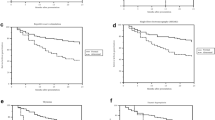Abstract
Myasthenia gravis is a chronic disease characterized by a fluctuating weakness of voluntary muscles, with a preference for the muscles innervated by the cranial nerves. Ocular symptoms (ptosis, diplopia) were present at onset in 65% of 432 own patients and in 10% of these patients the disease remained confined to the extrinsic eye muscles. A complete remission occurred in 30% of the purely ocular cases within 10 years of onset. The diagnosis depends upon the pattern of weakness, the spontaneous or provoked fluctuation of the symptoms and the favourable response to anticholinesterases. The presence of antibodies against acetylcholine receptor protein is the most recent tool to confirm the diagnosis, but they are absent in 10–20% of the patients with generalized MG and in 20–50% of the purely ocular cases. As the reaction to anticholinesterases in ocular MG is sometimes equivocal or even absent auxillary investigations (electromyography, tonography, nystagmography, curaretest) may be necessary. Oral anticholinesterases (Pyridostigmin, Prostigmin, Ambenomium) usually have a moderate effect on the ptosis and a poor effect on the diplopia so that other measures (ptosishooks, covering one eye) are necessary. In selected patients alternate-day Prednisone is the therapy of choice.
Similar content being viewed by others
References
Baloh RW and Keesey JC (1976) Saccade fatigue and response to edrophonium for the diagnosis of myasthenia gravis. Ann NY Acad Sci 274:631–641
Baptista AG and Silva e Souza H (1961) Pupillary abnormalities in myasthenia gravis. Neurology 11:210
Botelho SY, Deaterly Ch and Comroe JH (1952) EMG from orbicularis oculi in normal persons and in patients with myasthenia gravis. AMA Arch Neurol Psychiat 67:348
Breinin GM (1957) Electromyography. A tool in ocular and neurologic diagnosis. I Myasthenia gravis. AMA Arch Ophthal 57:161–164
Campbell, MJ, Simpson E, Combie AL and Walton JN (1970) Ocular myasthenia: evaluation of Tensilontomography and electronystagmography as diagnostic tests. J Neurol Neurosurg Psychiat 33:639–646
Cogan, DG (1965) Myasthenia gravis. A review of the disease and a description of lid twitch as a characteristic sign. Arch Ophthal 74:217–221
Engel AG (1979) Myasthenia gravis. In: Handbook of Clinical Neurology Ch 4: 95–145 Eds PJ Vinken and GW Bruyn. Amsterdam North Holland Publ Cie
Engel AG (1980) Morphologic and immunopathologic findings in myasthenia gravis and in congenital myasthenic syndromes. J Neurol Neurosurg Psychiat 43: 577–589
Esslen E (1977) Okulare Myasthenie und EMG der Augenmuskeln. In: Myasthenia Gravis: 72–76. Eds G Hertel, HG Mertens, K Ricker and K Schimrigk. Stuttgart Thieme
Fischer KC and Schwartzman RJ (1976) Oral corticosteroids in the treatment of ocular myasthenia gravis. Ann NY Acad Sci 274: 652–658
Glaser JS (1966) Myasthenic pseudo-internuclear ophthalmoplegia. Arch Ophthal 75: 363–366
Herishami Y and Lavy S (1971) Internal ophthalmoplegia in myasthenia gravis. Opthalmologica 163: 302–305
Hertel G, Ricker K and Hirsch A (1977) The regional curaretest in myasthenia gravis. J Neurol 214: 257–265
Hoogenraad TK, Jennekens FGI and Tan REWP (1979) Ophthalmoplegia due to myasthenia gravis. Histological and histochemical observations in the inferior oblique muscle. Docum Ophthal Proc Ser 17: 27–34
Horowitz S and Sivak M (1978) The regional curaretest and electrophysiologic diagnosis of myasthenia gravis: further studies. Muscle and Nerve I: 432–434
Lepore, FE, Sanborn GE and Slevin J (1979) Pupillary dysfunction in myasthenia gravis. Ann Neurol 6: 29–33 (1979)
Limburg PC, Hummel E, The H and Oosterhuis HJ (1981) Relationship between changes in anti-acetylcholine receptor antibody concentration and disease severity in myasthenia gravis. Ann N.Y. Acad Sci (in press)
Marek P and Szobor A (1966) Die Bedeutung der Okulo-Elektromyographie in der Diagnose der Myasthenie. Nervenarzt 37: 501–507
Mastaglia FL, Black JL, Collins DWK and Dawkins RL (1977) Saccadic velocities in diagnosis of myasthenia gravis. Lancet II: 83
Oosterhuis HJ (1981) Observations on the natural history of myasthenia gravis. Ann NY Acad Sci (in press)
Oosterhuis HJ and Bethlem J (1973) Neurogenic muscle involvement in myasthenia gravis. J Neurol Neurosurg Psychiat 36: 244–254
Oosterhuis HJ (1977) Epidemiologie der Myasthenie in Amsterdam. In: Myasthenia Gravis: 103–108. Eds, G. Hertel, HG Mertens, K Ricker and K Schimrigk. Stuttgart Thieme
Oosterhuis HJ (1981) Myasthenia gravis. A review. Clin Neurol Neurosurg (in press)
Oppenheim H (1901) Die myasthenische Paralyse (Bulbärparalyse ohne anatomischen Befund). Berlin Karger
Osher RH and Griggs RC (1979) Orbicularis fatigue. The ‘Peek’ sign of myasthenia gravis. Arch Ophthal 97: 677–679
Osserman KE (1958) Myasthenia gravis. New York Grüne & Stratton
Remus I and Lahl R (1974) Beitrag zur Pathohistologie der äusseren Augenmuskulatur bei Myasthenia gravis pseudoparalytica. Klin Mbl Augenheilk 164: 776–783
Retzlaff JA, Kearns TP, Howard FM and Cronin ML (1969) Lancaster red-green test in evaluation of edrophonium effect in myasthenia gravis. Amer J Ophthal 67: 13–21
Sakimoto T and Cheng-Minoda K (1970) Fine structure of neuromuscular junctions in myasthenic extraocular muscles. Invest Ophthal 9: 316–324
Schmidt D, Dell'Osso LF, Abel LA and Daroff RB (1980) Myasthenia gravis: dynamic changes in saccadic wave form: gain and velocity. Exp Neurol 68: 365–377
Schmidt D (1975) Diagnostik myasthenischer Augensymptome. Klin Mbl Augenheilk 167: 651–664
Seybold M and Lindstrom JM (1981) Patterns of acetylcholine receptor antibody fluctuation in myasthenia gravis. Ann NY Acad Sci (in press)
Simpson JA (1960) Myasthenia gravis, a new hypothesis. Scot Med J 5: 419–436
Spector RH and Daroff RB (1977) Edrophonium infrared optokinetic nystagmography in the diagnosis of myasthenia gravis. Ann NY Acad Sci 274: 642–651
Viets HR and Schwab RS (1935) Prostigmin in the diagnosis of myasthenia gravis. New Engl J Med 213: 1280
Vincent A and Newsom Davis J (1980) Anti-acetylcholine receptor antibodies. J Neurol Neurosurg Psychiat 43: 590–600
Walker M (1934) Treatment of myasthenia gravis with Prostigmine. Lancet 226: 1200–1201
Yamazaki A and Ishikawa S (1976) Abnormal pupillary responses in myasthenia gravis. Brit J Ophthal 60: 575
Yee FD, Cogan DG, Zee DS, Baloh RW and Honrubia V (1976) Rapid eye movements in myasthenia gravis. II Electro-oculographic analysis. Arch Ophthal 94: 1465–1472
Author information
Authors and Affiliations
Rights and permissions
About this article
Cite this article
Oosterhuis, H.J.G.H. The ocular signs and symptoms of myasthenia gravis. Doc Ophthalmol 52, 363–378 (1982). https://doi.org/10.1007/BF01675867
Issue Date:
DOI: https://doi.org/10.1007/BF01675867




